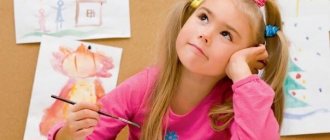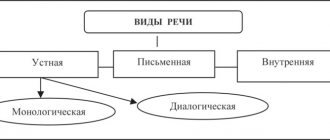In our time of technical breakthrough, a key place is given to the development of human creative abilities. Executive work is transferred to machines and automatic machines, the role of the author belongs to a person of the 21st century - a person with a rich imagination who knows how to find non-standard solutions. The formation of creative abilities begins in childhood, in preschool age. Therefore, diagnosing the imagination of a preschooler occupies a separate place in the education and development program in kindergarten.
Psychological methods for diagnosing the imagination of preschool children
Margarita Chernykhovskaya
Psychological methods for diagnosing the imagination of preschool children
The question of diagnostic methods and criteria for assessing children's imagination is raised in the works of many researchers. Experimental studies of children's imagination and creativity in modern psychology are based primarily on the method of quantitative assessments of the results of specially designed tests.
The methodological basis of most of these works is the theory of creative intelligence, developed in the 50s by J. Guilford, P. Torrance and their followers. Its essence is that, on the basis of factor analysis, individual components of creative thinking were identified (creativity factors that characterize forms of productive activity: flexibility, sophistication, originality, fluency. Based on this theory, tests were created in which these factors are an indicator of creative child's abilities.
To determine the level of development of creative processes, tasks such as constructing an object from these materials are proposed; finding different classification options for sets of objects , figures and letters; finishing an unfinished drawing; compiling a large number of drawings from given elements; coming up with different ways to use objects ; completing a sentence in various ways; coming up with possible consequences of extraordinary events; coming up with titles for a given picture or story; finding commonality between given objects or phenomena; asking questions about one picture; improvement of a given subject, etc.
At the same time, as we see, some of the tasks are clearly aimed at diagnosing creative thinking (for example, classification of sets of objects , figures, and some are aimed at the imagination (for example, completing drawings of figures)
. The specifics of these processes were practically not highlighted in these studies.
It seems to us, following O. M. Dyachenko, that the most adequate criterion for analyzing the main trends in the development of imagination is such a criterion as “originality”
Originality reflects the degree of individualization in the performance of creative tasks. But it is precisely this parameter that causes the greatest number of objections . Thus, S. Mednik and M. Mednik write that “originality is perhaps the easiest reaction that people are capable of. It is much more difficult to be a conventionalist than to be an originalist. For example, to the question of what the sum of 4+4 is equal to, one can answer 1367854. This is extremely original, because hardly anyone in the whole world has given a similar answer before. However, such a response cannot be called creative.”
O. M. Dyachenko proposes, along with the criterion of originality, to use the criterion of the direction of imagination . The fluence parameter reflects the contradiction between the instability, dynamism of imagination and the need to subordinate these images to the fulfillment of the assigned task, to direct them to the creation of a creative product, that is, it is the productivity, the direction of the imagination - not the spontaneity of emerging images, but their subordination to the assigned task. The flexibility parameter reflects the contradictions, on the one hand, between the actually perceived object and the meaning the child puts into it, and on the other hand, between the images of the imagination and the means for their implementation in each type of activity. Originality, combined with fluency and flexibility, can express the real novelty of imaginative , the novelty of the approach to the task. The use of these parameters becomes adequate for assessing the level of development of the creative components of a child’s productive imagination when analyzing the results of performing special tasks.
Methodology “Completing Figures”
.
Developed by O. M. Dyachenko, it is a variant of the E method . P. Torrens, is aimed at determining the level of development of imagination , the ability to create original images.
The material used is one (of two proposed)
a set of cards, on each of which one figure of an indeterminate shape is drawn. There are 10 cards in total in each set.
2 equivalent sets of such figures have been developed.
During the first examination, one of these kits is offered; another kit can be used during the second examination or after a year.
(KOR) was taken as the main quantitative indicator for assessing the level of success in completing tasks.
: Number of non-repeating images.
This is a complex indicator that records such parameters as fluency (the number of correct answers corresponding to the task, flexibility (the number of different categories of answers, that is, the variability of answers in one child) and originality (the frequency of the answer in a group
of children ) .
Along with the quantitative processing of the results, a qualitative description of the levels of task completion was carried out. The originality coefficient was correlated with one of the six main types of solving an imagination , in accordance with the “complexity”
O. M. Dyachenko, which made it possible to reveal the characteristics of children's
imagination , which ensures one or another level of fulfillment of creative tasks.
Methodology “Writing a fairy tale”
O. M. Dyachenko.
This technique was used to identify the level of development of creative imagination . The children were offered the following instructions: “Create your own fairy tale that you have never heard, no one told you.”
Then the child's composition was recorded in detail. When assessing essays, the child was given 0 points if he refused the task or retold a familiar fairy tale; if a child retold a familiar fairy tale, but made some modifications, then he received 1 point; If the child was based on some well-known fairy tales, but changed them significantly, he was given 2 points. Such changes could concern the characters of a fairy tale while maintaining the general plot (for example, a fairy tale is not about three little pigs, but about three bunnies)
or changes in the plot, but with the preservation of the characters
(a fairy tale about a wolf and a hare who perform some new actions)
. At the same time, the story as a whole is schematic, without details. For a fairy tale composed in the same way (with a score of 2 points, but expanded and detailed), the child received 3 points.
A fairy tale about characters invented by the child himself, who also performed actions invented by him, was scored 4 points. The fairy tale was created completely independently, but it was schematic. And finally, when a child composed a fairy tale independently, and the presentation was detailed and detailed, the author was given 5 points.
To study the cognitive activity “Wish Tree” technique is used.
V. S. Yurkevich.
Pictures and verbal situations are used as stimulus material. Children are asked to answer 6 problematic questions. The answer time for each question is from 4 to 6 minutes. From the answers, answers of a cognitive nature are selected. Quantitative and qualitative analysis is possible.
High level of cognitive need – 9 answers and above. Children are characterized by a desire to penetrate into the cause-and-effect relationships of phenomena, and an exploratory interest in the world is clearly manifested .
Average level – from 3 to 8 answers. There is a need for knowledge, but only specific information, and rather superficial information at that, is attracted.
Low level – 2 or fewer answers. Children are satisfied with monosyllabic information, for example, they are interested in the reality of a fairy tale, legend, etc. they once heard.
All these judgments are cognitive in nature, but differ in different levels of complexity.
"How to save a bunny"
V. T. Kudryavtseva.
the methodology to study the creative initiative of children , the ability to generate (search for)
supra-situational
(creative)
solutions, and allowed us to assess the ability to transform a choice task into a transformation task as a manifestation of creative supra-situational
(initiative)
.
Instructions: “Meet this bunny. One day such a story happened to him. The bunny decided to sail on a boat and sailed far, far from the shore. And then suddenly a storm began, huge waves appeared, and the bunny began to drown. Only you and I can help the bunny. We have several things for this. Here you go - get acquainted - a small wooden stick, a toy plate, a bucket, a deflated balloon, a sheet of blank paper. You are invited to choose from them those with which you can save the bunny.”
After the child has made a choice of items , he is asked to justify why.
Children's answers were compared with three main types of solutions to a given situation, identified by the author. Three main types of children's decisions.
1 type Children chose a possible means of salvation, trying to use alternative objects in ready-made form, transfer them to a new situation without any “adjustment”
(with a stick, to pick up a bunny)
.
Type 2 Children transform an object into a form of symbolic substitution (the stick appeared as a “substitute”
logs or a boat where it was proposed to put the bunny).
Type 3 The children had an attitude toward transforming subject material. The original choice task was independently rethought (problematized)
them and turned into a task of transformation.
(Inflate a balloon, make a paper boat out of a sheet)
.
According to the instructions, the child was asked to choose, and not to transform at all. The experimenter deliberately avoided the words “transform”
,
“remake”
, carriers of
the “transformational initiative”
.
We also took into account the levels of children's responses when solving problems .
Five levels of children’s when solving problems involving supra-situationalism (initiative)
.
Level 1. Refusal to choose. Doesn't accept the task (I don't know)
or claims that the problem cannot be solved, that is, he does not see in the proposed material a means for solving it.
Level 2. A simple situational solution. The child is not out of bounds
a simple choice, trying to use objects in finished form, mechanically transfer their external empirical properties to a new situation. The same level includes answers of the so-called arbitrary type, when children believe, for example, that one of the objects is magical or fairy-tale and therefore can do what they want; children mechanically remove the problem instead of solving it. In this case, the actions of the object are independent of its specific properties.
Level 3. Solutions with elements of simple symbolism. The child uses an element of magic and fabulousness, but at the same time takes into account the specifics of the subject.
Level 4. Trans-situational solutions. Children a focus on transforming available object material. They independently and proactively transform the initial task of choice into a task of transformation. This type of solution is associated with a holistic transformation of the situation.
Level 5. Complex supra-situational decisions. The child does not limit himself to transforming an object, but goes further: he additionally transforms the object or builds an integral situation by transforming several objects .
Method 13. “Verbal fantasy” (verbal imagination)
During the story, the child’s imagination is assessed according to the following criteria:
- 1. Speed of imagination processes.
2. Unusuality, originality of images.
3. Wealth of imagination.
4. Depth and elaboration (detail) of images.
5. Impressionability, emotionality of images.
For each of these characteristics, the story receives from 0 to 2 points.
0 points are given when this feature is practically absent from the story. A story receives 1 point if this feature is present, but expressed relatively weakly. A story earns 2 points when the corresponding feature is not only present, but also expressed quite strongly.
If within 1 minute the child has not come up with a plot for the story, then the experimenter himself suggests some plot to him and gives him 0 points for the speed of imagination. If the child himself came up with the plot of the story by the end of the allotted minute, then according to the speed of imagination he receives a score of i point. Finally, if the child managed to come up with the plot of the story very quickly, during the first 30 seconds of the allotted time, or if within one minute he came up with not one, but at least two different plots, then according to the “speed of imagination processes” the child is given 2 points.
The unusualness and originality of images is assessed in the following way. If a child simply retold what he once heard from someone or saw somewhere, then he receives 0 points for this criterion. If a child retells what is known, but at the same time brings something new into it, then the originality of his imagination is assessed at 1 point. Finally, if a child came up with something that he could not see or hear anywhere before, then the originality of his imagination receives a score of 2 points.
The richness of a child’s imagination is also manifested in the variety of images he uses. When assessing this quality of imagination processes, the total number of different living beings, objects, situations and actions, various characteristics and signs attributed to all of this in the child’s story is recorded.
If the total number named exceeds 10, then the child receives 2 points for the richness of imagination. If the total number of parts of the specified type is in the range from 6 to 9, then the child receives 1 point. If there are few signs in the story, but overall no less than 5, then the richness of the child’s imagination is assessed as 0 points.
The depth and elaboration of images are determined by how diversely the story presents details and characteristics related to the image (person, animal, fantastic creature, object, item, etc.) that plays a key role or occupies a central place in the story. Grades are also given here in a three-point system.
A child receives 0 points when the central object of his story is depicted very schematically, without detailed elaboration of its aspects. 1 point is given if, when describing the central object of the story, its detail is moderate. A child receives 2 points for the depth and elaboration of images if the main image of his story is described in sufficient detail, with many different details characterizing it.
The impressionability or emotionality of images is assessed by whether they arouse interest and emotion in the listener.
If the images used by the child in his story are uninteresting, banal, and do not make an impression on the listener, then according to the criterion under discussion, the child’s fantasy is assessed at 0 points. If the images of the story arouse interest on the part of the listener and some emotional response, but this interest, along with the corresponding reaction, soon fades away, then the impressionability of the child’s imagination receives a score of 1 point. And, finally, if the child used bright, very interesting images, the listener’s attention to which, once aroused, did not fade away and even intensified towards the end, accompanied by emotional reactions such as surprise, admiration, fear, etc., then the impressionability of the story The child is assessed with the highest score - 2.
Thus, the maximum number of points that a child can receive for his imagination in this technique is 10, and the minimum is 0.
In order to make it easier for the experimenter, while listening to a child’s story, to record and further analyze the products of his imagination according to all the parameters listed above, it is recommended to use the scheme presented in Table 5. It must be prepared in advance, before the start of the examination.
As the child’s story progresses, the child’s fantasy ratings in points are marked with a cross in the required column of this table.
Conclusions about the level of development
- 10 points – very high.
8-9 points - high.
4-7 points - average.
2-3 points - low.
0-1 point - very low.
METHODS OF DIAGNOSTICS OF ATTENTION
The following set of techniques is intended for studying the attention of children, assessing such qualities of attention as productivity, stability, switchability and volume. Each of these characteristics can be considered separately and at the same time as a partial assessment of attention as a whole. To diagnose the listed characteristics of attention, various methodological techniques are proposed. At the end of the examination of the child using all four methods presented here related to attention, it is possible to derive a general, integral assessment of the level of development of the preschooler’s attention. All individual assessments of attention, as in the previous case, are entered into the Individual Card of the child’s psychological development.
Method 5. “Find and cross out”
The task contained in this technique is intended to determine the productivity and stability of attention. The child is shown rice. 5. It shows images of simple figures in random order: a mushroom, a house, a bucket, a ball, a flower, a flag. Before starting the study, the child receives the following instructions:
Rice. 5 Matrix with figures for the task “Find and cross out” for children from three to four years old.
Rice. 6 Matrix with figures for the task “Find and cross out” for children aged four to five years.
“Now you and I will play this game: I will show you a picture in which many different objects that are familiar to you are drawn. When I say the word “begin,” along the lines of this drawing you will begin to look for and cross out the objects that I name. It is necessary to search and cross out the named objects until I say the word “stop”. At this time, you must stop and show me the image of the object that you saw last. After that, I will mark on your drawing the place where you stopped and again say the word “start.” After that you will continue to do the same thing, i.e. look for and cross out given objects from the picture. This will happen several times until I say the word “end.” This completes the task."
In this technique, the child works for 2.5 minutes, during which he is told the words “stop” and “start” five times in a row (every 30 seconds).
In this technique, the experimenter gives the child the task of looking for and crossing out any two different objects in different ways, for example, crossing out an asterisk with a vertical line, and a house with a horizontal line. The experimenter himself marks in the child’s drawing those places where the corresponding commands are given.
Processing and evaluation of results
When processing and evaluating the results, the number of objects in the picture viewed by the child within 2.5 minutes is determined, i.e. for the entire duration of the task, as well as separately for each 30-second interval. The data obtained is entered into a formula that determines the general indicator of the child’s level of development of two properties of attention simultaneously: productivity and stability:
where S is an indicator of productivity and stability of attention of the examined child;
N is the number of images of objects in Fig. 5 (6) viewed by the child during work;
t – operating time;
n – number of errors made during work. Errors are considered to be missing necessary images or crossing out unnecessary images.
As a result of the quantitative processing of psychodiagnostic data, six indicators are determined using the above formula, one for the entire time of working on the technique (2.5 minutes), and the rest for each 30-second interval. Accordingly, the t variable in the method will take values of 150 and 30.
Based on all indicators S obtained during the task, a graph of the following type is constructed (Fig. 8), based on the analysis of which one can judge the dynamics of changes over time in the productivity and stability of the child’s attention. When constructing a graph, productivity and sustainability indicators are converted (each separately) into points on a ten-point system as follows:
10 points – the child’s S score is higher than 1.25 points
8-9 points – the S indicator is in the range from 1.00 to 1.25 points 10 points – the child’s S indicator is higher than 1.25 points
6-7 points – the S indicator is in the range from 0.75 to 1.00 points
4-5 points – the S indicator ranges from 0.50 to 0.75 points
2-3 points – the S indicator ranges from 0.24 to 0.50 points
0-1 point – S indicator is in the range from 0.00 to 0.2 points
Sustainability of attention, in turn, is scored as follows:
10 points – all points of the graph in Figure 8 do not extend beyond one zone, and the graph itself in its shape resembles curve 1
8-9 points – all points of the graph are located in two zones like curve 2
Rice. 7 Variants of graphs showing the dynamics of productivity and stability of attention using the “Find and Cross Out” method
The graph shows various productivity zones and typical curves that can be obtained as a result of psychodiagnostics of a child’s attention using this method. These curves are interpreted as follows
1 Curve shown using a line like –.–.–. This is a chart of very highly productive and sustained attention.
2 Curve represented by a line like This is a graph of low-productive but sustained attention
3 A curve represented by a line of the type – – – – –. Represents a graph of average productive and average sustained attention
4 The curve depicted using the line _____ Is a graph of moderately unproductive but unstable attention
5 Curve represented by the line – – – – –. Represents a graph of moderately productive and extremely unstable attention
6-7 points – all points of the graph are located in three zones, and the curve itself is similar to graph 3
4-5 points – all points of the graph are located in four different zones, and its curve is somewhat reminiscent of graph 4
3 points – all points of the graph are located in five zones, and its curve is similar to graph 5
Conclusions about the level of development
10 points – productivity of attention is very high, stability of attention is very high
8-9 points – high productivity of attention, high stability of attention
4-7 points – productivity of attention is average, stability of attention is average
2-3 points – productivity of attention is low, stability of attention is low
0-1 point – productivity of attention is very low, stability of attention is very low
“Put icons” technique
The test task in this technique is intended to assess the switching and distribution of the child’s attention. Before starting the task, the child is shown a picture. 8 and explain how to work with it. This work consists of putting in each of the squares, triangles, circles and diamonds the sign that is given at the top of the sample, i.e., respectively, a tick, a line, a plus or a dot.
The child works continuously, performing this task for two minutes, and the overall indicator of switching and distribution of his attention is determined by the formula:
where S is an indicator of switching and distribution of attention;
N – the number of geometric shapes viewed and marked with appropriate signs within two minutes;
n – the number of errors made during the task. Errors are considered to be incorrectly placed or missing signs, i.e. geometric shapes not marked with appropriate signs.
Evaluation of results
10 points – S score is more than 1.00
8-9 points – the S indicator ranges from 0.75 to 1.00
6-7 points – the S indicator ranges from 0.50 to 0.75
4-5 points – the S indicator is in the range from 0.25 to 0.50
0-3 points – the S indicator ranges from 0.00 to 0.25
Conclusions about the level of development
10 points – very high.
8-9 points – high.
6-7 points – average.
4-5 points – low.
0-3 points – very low.
Rice. 8 Sheet for the “Put icons” method
“Remember and dot the dots” technique
Using this technique, the child’s attention span is assessed. For this purpose, the stimulus material shown in Fig. is used. 9 The sheet with dots is pre-cut into 8 small squares, which are then folded into a stack so that at the top there is a square with two dots, and at the bottom - a square with nine dots (all the rest go from top to bottom in order with a successively increasing number of dots on them) .
Before the experiment begins, the child receives the following instructions:
“Now we’ll play a game of attention with you. I will show you cards one by one with dots on them, and then you yourself will draw these dots in the empty cells in the places where you saw these dots on the cards.”
Next, the child is shown sequentially, for 1-2 seconds, each of eight cards with dots from top to bottom in a stack in turn, and after each next card he is asked to reproduce the dots he saw in an empty card (Fig. 10) in 15 seconds. This time is given to the child so that he can remember where the dots he saw were located and mark them on a blank card.
Evaluation of results
The child’s attention span is considered to be the maximum number of dots that the child was able to correctly reproduce on any of the cards (the one from the cards on which the largest number of dots was accurately reproduced is selected). The results of the experiment are scored as follows:
10 points – the child correctly reproduced 6 or more dots on the card within the allotted time
8-9 points – the child accurately reproduced 4 to 5 dots on the card
6-7 points – the child correctly recalled from memory 3 to 4 points
4-5 points – the child correctly reproduced from 2 to 3 points
0-3 points – the child was able to correctly reproduce no more than one point on one card








